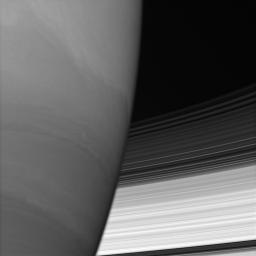
|
Saturn Hides the Rings
- Click the image above for a larger view
- Full-Res JPEG (1020 x 1020) (56.7 kB)
- Full-Res TIFF (1020 x 1020) (1.0 MB)
Caption:
Saturn's B and C rings disappear behind the immense planet. Where they meet the limb, the rings appear to bend slightly owing to upper-atmospheric refraction.
Crenulations --irregularly wavy or serrated features -- in the planet's clouds denote the locations of turbulent belt/zone boundaries.
The image was taken using a spectral filter sensitive to wavelengths of infrared light centered at 728 nanometers. The view was obtained with the Cassini spacecraft wide-angle camera on Aug. 16, 2006 at a distance of approximately 256,000 kilometers (159,000 miles) from Saturn. Image scale is 12 kilometers (7 miles) per pixel.
Background Info:
The Cassini-Huygens mission is a cooperative project of NASA, the European Space Agency and the Italian Space Agency. The Jet Propulsion Laboratory, a division of the California Institute of Technology in Pasadena, manages the mission for NASA's Science Mission Directorate, Washington, D.C. The Cassini orbiter and its two onboard cameras were designed, developed and assembled at JPL. The imaging operations center is based at the Space Science Institute in Boulder, Colo.
For more information about the Cassini-Huygens mission visit http://saturn.jpl.nasa.gov/home/index.cfm . The Cassini imaging team homepage is at http://ciclops.org .
Cataloging Keywords:
| Name | Value | Additional Values |
|---|---|---|
| Target | Saturn Rings | B Ring, C Ring, Saturn |
| System | Saturn | |
| Target Type | Ring | Planet |
| Mission | Cassini-Huygens | |
| Instrument Host | Cassini Orbiter | |
| Host Type | Orbiter | |
| Instrument | Imaging Science Subsystem (ISS) | |
| Detector | Wide Angle Camera | |
| Extra Keywords | Atmosphere, Disk, Grayscale, Infrared, Visual, Wave | |
| Acquisition Date | ||
| Release Date | 2006-09-12 | |
| Date in Caption | 2006-08-16 | |
| Image Credit | NASA/JPL/Space Science Institute | |
| Source | photojournal.jpl.nasa.gov/catalog/PIA08265 | |
| Identifier | PIA08265 | |
